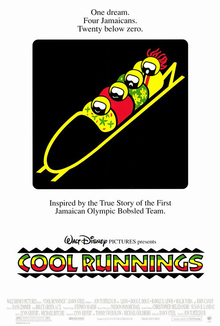Like all good people, I am currently obsessed with the Winter Olympics. Earlier this week, I asked some of my closest friends if they could recommend some good films about the Winter Games. Almost everyone who replied recommended that I check out Cool Runnings, a film from 1993.
So, I did.
And I’m glad that I did.
Cool Runnings is one of those sports movies that’s based on a true story, though I imagine it’s probably a very loose adaptation. Jamaica is a country with a long and proud Olympic history. Since the 1948 Summer Olympics, Jamaican athletes have won a total of 77 medals, the majority of them in individual and relay sprinting events. However, Jamaica didn’t compete in the Winter Olympics until 1988, when the Jamaican Bobsled Team made their debut. According to contemporary news reports, the Jamaicans were folk heroes at the ’88 Winter Games and other teams would frequently help them out by lending them equipment. Though the Jamaicans were never really a medal contender, they were personally popular and everyone was upset when their bobsled crashed during one of their qualifying runs.
That, of course, isn’t exactly the story that’s told in Cool Runnings. In Cool Runnings, the Jamaican bobsled team is ridiculed by all of the snobs on the other teams, with the Germans especially going out of their way to be condescending. Their first run is a disaster but their second run puts them into medal contention and causes people all over the world to spontaneously break into applause. It’s a sports film, after all. For a sports film to work, there has to be adversity before there can be victory. Cool Runnings does stick close enough to the real story that the Jamaicans do end up crashing their sled. However, in the film version, the team proudly carries their bobsled over the finish line while, again, people all around the world applaud. Even a woman with a Russian flag claps. And yes, it’s all pretty hokey but who cares? It made me cry.
It’s a well-done film, one that is unapologetically sentimental and all the better for it. Before I watched the film, I didn’t know anything about how the bobsled worked, beyond the fact that it involved four people and that everyone had to jump into the sled after launching it. But, ultimately, it didn’t matter that I didn’t know much about bobsledding. From the moment that film started, with scenes of aspiring Olympians running across sunny Jamaica, it had my attention.
When the film starts, Derice Bannock (Leon Robinson) is hoping to compete in the Summer Olympics but, at the qualifying trial, Derice and another runner, Yul Brenner (Malik Yorba), end up tripping over yet another runner, the likable and enthusiastic Junior Bevil (Rawle D. Lewis). Out of contention for the Summer Olympics, Derice decides to try to find a way to go to the Winter Olympics. Fortunately, there’s a former Olympic bobsledder, Irv Blitzer (John Candy), living nearby and Derice’s best friend, Sanka (Doug E. Doug) is a champion push cart racer.
The film follows Irv and the four Jamaicans on their unlikely journey to Canada. It’s a comedy with a dramatic heart. Yes, Sanka may need help getting his helmet over his hair (“Thanks, coach,” he says whenever Irv pounds down the helmet) but the film also takes the time to explore why it’s so important for these four to compete in the first place. It might be tempting to make fun of Yul Brenner when he talks about how he wants to live in Buckingham Palace but the film makes clear just how important this improbable dream is for Yul and everyone else. No one may give the Jamaican bobsled team a chance but Jamaica never stops believing in them.
It’s an incredibly sweet little movie, featuring likable performances and a heart-warming story. I highly recommend it to anyone looking for a good sports story.

 Los Angeles in the 80s. Beneath the California glamour that the rest of America thinks about when they think about L.A., a war is brewing. Bloods vs Crips vs the 21st Street Gang. For those living in the poorest sections of the city, gangs provide everything that mainstream society refuses to provide: money, a chance to belong, a chance to advance. The only drawback is that you’ll probably die before you turn thirty. Two cops — veteran Hodges (Robert Duvall) and rookie McGavin (Sean Penn) — spend their days patrolling a potential war zone. Hodges tries to maintain the peace, encouraging the gangs to stay in their own territory and treat each other with respect. McGavin is aggressive and cocky, the type of cop who seems to be destined to end up on the evening news. With only a year to go before his retirement, Hodges tries to teach McGavin how to be a better cop while the gangs continue to target and kill each other. The cycle continues.
Los Angeles in the 80s. Beneath the California glamour that the rest of America thinks about when they think about L.A., a war is brewing. Bloods vs Crips vs the 21st Street Gang. For those living in the poorest sections of the city, gangs provide everything that mainstream society refuses to provide: money, a chance to belong, a chance to advance. The only drawback is that you’ll probably die before you turn thirty. Two cops — veteran Hodges (Robert Duvall) and rookie McGavin (Sean Penn) — spend their days patrolling a potential war zone. Hodges tries to maintain the peace, encouraging the gangs to stay in their own territory and treat each other with respect. McGavin is aggressive and cocky, the type of cop who seems to be destined to end up on the evening news. With only a year to go before his retirement, Hodges tries to teach McGavin how to be a better cop while the gangs continue to target and kill each other. The cycle continues.